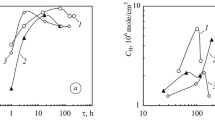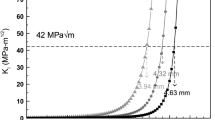Abstract
Stress corrosion cracking is a problem of major concern in pipeline steels. This paper deals with the fracture mechanics approach to the phenomenon. Paraphrasing the famous sentence by Ortega y Gasset “yo soy yo y mi circunstancia”, one could say that the material is itself and its circumstance, the latter being the physico-chemical and mechanical environment. The paper analyzes situations in which the circumstance enhances hydrogen embrittlement. A theoretical study is provided of the validity of the fracture mechanics approach to hydrogen assisted cracking, analyzing the K-dominance condition to elucidate the role of the far field and the effect of history, the latter recalling the words of the Spanish poet Antonio Machado: “hoy es siempre todavía”, and perhaps T. S. Eliot’s “and all is always now”.
Access this chapter
Tax calculation will be finalised at checkout
Purchases are for personal use only
Similar content being viewed by others
References
W. Wang, Y.Y. Shan, K. Yang, Study of high strength pipeline steels with different microstructures. Mater. Sci. Eng. A502, 38–44 (2009)
W. Wang, W. Yan, L. Zhu, P. Hu, Y.Y. Shan, K. Yang, Relation among rolling parameters, microstructures and mechanical properties in an acicular ferrite pipeline steel. Mater. Des. 30, 3436–3443 (2009)
F.R. Xiao, B. Liao, Y.Y. Shan, G.Y. Qiao, Y. Zhong, C. Zhang, K. Yang, Challenge of mechanical properties of an acicular ferrite pipeline steel. Mater. Sci. Eng. A431, 41–52 (2006)
M.C. Zhao, K. Yang, Y.Y. Shan, The effects of thermo-mechanical control process on microstructures and mechanical properties of a commercial pipeline steel. Mater. Sci. Eng. A335, 14–20 (2002)
J.E. Hood, Fracture of steel pipelines. Int. J. Pres. Ves. Piping 2, 165–178 (1974)
S.O. Kotrechko, A.Y. Krasowsky, Y.Y. Meshkov, V.M. Torop, Effect of long-term service on the tensile properties and capability of pipeline steel 17GS to resist cleavage fracture. Int. J. Pres. Ves. Piping 81, 337–344 (2004)
M.S. Kumar, M. Sujata, M.A. Venkataswamy, S.K. Bhaumik, Failure analysis of a stainless steel pipeline. Eng. Fail. Anal. 15, 497–504 (2008)
V.D. Makarenko, M.Y. Mukhin, I.O. Makarenko, S.Y. Safronova, Crack resistance of pipe steels in industrial oil pipelines. Chem. Petrol. Eng. 44, 672–675 (2008)
E. Gamboa, V. Linton, M. Law, Fatigue of stress corrosion cracks in X65 pipeline steels. Int. J. Fatigue 30, 850–860 (2008)
D. Hardie, E.A. Charles, A.H. López, Hydrogen embrittlement of high strength pipeline steels. Corros. Sci. 48, 4378–4385 (2006)
A. Torres-Islas, V.M. Salinas-Bravo, J.L. Albarrán, J.G. González-Rodríguez, Effect of hydrogen on the mechanical properties of X-70 pipeline steel in diluted NaHCO3 solutions at different heat treatments. Int. J. Hydrogen Energy 30, 1317–1322 (2005)
J. Toribio, V. Kharin, The reliability of the fracture mechanics approach to environmentally assisted cracking: 1. Uniqueness of the v(K)-curve. Mater. Des. 18, 87–94 (1997a)
J. Toribio, V. Kharin, The reliability of the fracture mechanics approach to environmentally assisted cracking: 2. Engineering safe design. Mater. Des. 18, 95–101 (1997b)
J. Toribio, V. Kharin, Evaluation of hydrogen assisted cracking: the meaning and significance of the fracture mechanics approach. Nucl. Eng. Des. 182, 149–163 (1998)
J. Toribio, V. Kharin, K-Dominance condition in hydrogen assisted cracking: the role of the far field. Fatigue Fract. Eng. Mater. Struct. 20, 729–745 (1997c)
J. Toribio, V. Kharin, The effect of history on hydrogen assisted cracking: 1. Coupling of hydrogenation and crack growth. Int. J. Fracture 88, 233–245 (1997d)
J. Toribio, V. Kharin, The effect of history on hydrogen assisted cracking: 2. A revision of K-dominance. Int. J. Fracture 88, 247–258 (1997e)
Acknowledgements
Many results summarized in this paper are taken from previous works reported in the list of references. Special acknowledgement is gratefully given to the co-author of such papers: Dr. Viktor Kharin (formerly with the Pidstryhach Institute for Applied Mechanics and Mathematics of Lvov, now Associate Professor at the University of Salamanca).
Previous research works in which this paper is based were funded by the Spanish Institutions CICYT (Grant MAT97-0442), DGICYT (Grants UE94-0001 and SAB95-0122), and Xunta de Galicia (Grants XUGA 11801A93, 11801B95 and 11802B97) and the European Institutions CEE (Human Capital and Mobility) and NATO (Scientific Programme).
In addition, the author wishes to thank the financial support of his research at the University of Salamanca provided by the Spanish Institutions MCYT (Grant MAT2002-01831), MEC (Grant BIA2005-08965), MCINN (Grant BIA2008-06810), JCyL (Grants SA067A05, SA111A07 and SA039A08).
Author information
Authors and Affiliations
Corresponding author
Editor information
Editors and Affiliations
Rights and permissions
Copyright information
© 2011 Springer Science+Business Media B.V.
About this paper
Cite this paper
Toribio, J. (2011). Fracture Mechanics Approach to Stress Corrosion Cracking of Pipeline Steels: When Hydrogen Is the Circumstance. In: Bolzon, G., Boukharouba, T., Gabetta, G., Elboujdaini, M., Mellas, M. (eds) Integrity of Pipelines Transporting Hydrocarbons. NATO Science for Peace and Security Series C: Environmental Security, vol 1. Springer, Dordrecht. https://doi.org/10.1007/978-94-007-0588-3_4
Download citation
DOI: https://doi.org/10.1007/978-94-007-0588-3_4
Published:
Publisher Name: Springer, Dordrecht
Print ISBN: 978-94-007-0587-6
Online ISBN: 978-94-007-0588-3
eBook Packages: Earth and Environmental ScienceEarth and Environmental Science (R0)




